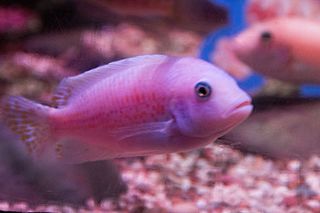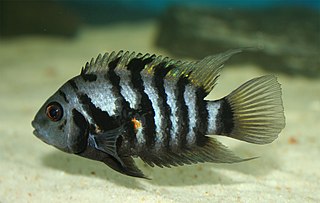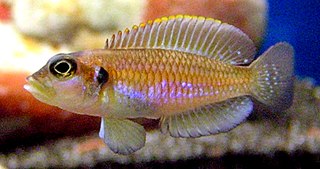
Cichlids are fish from the family Cichlidae in the order Cichliformes. Traditionally Cichlids were classed in a suborder, the Labroidei, along with the wrasses (Labridae), in the order Perciformes, but molecular studies have contradicted this grouping. On the basis of fossil evidence, it first appeared in Tanzania during the Eocene epoch, about 46–45 million years ago. The closest living relative of cichlids is probably the convict blenny, and both families are classified in the 5th edition of Fishes of the World as the two families in the Cichliformes, part of the subseries Ovalentaria. This family is large, diverse, and widely dispersed. At least 1,650 species have been scientifically described, making it one of the largest vertebrate families. New species are discovered annually, and many species remain undescribed. The actual number of species is therefore unknown, with estimates varying between 2,000 and 3,000.

The oscar is a species of fish from the cichlid family known under a variety of common names, including tiger oscar, velvet cichlid, and marble cichlid. In tropical South America, where the species naturally resides, A. ocellatus specimens are often found for sale as a food fish in the local markets. The fish has been introduced to other areas, including India, China, Australia, and the United States. It is considered a popular aquarium fish in Europe and the U.S.

The black phantom tetra, or simply phantom tetra, is a small freshwater fish of the characin family (Characidae) of order Characiformes. It is native to the upper Paraguay basin and upper Madeira basin in Brazil and Bolivia. It is commonly seen in the aquarium trade.

The firemouth cichlid is a species of cichlid fish native to Central America. They occur in rivers of the Yucatán Peninsula, Mexico, south through Belize and into northern Guatemala.

The convict cichlid is a fish species from the family Cichlidae, native to Central America, also known as the zebra cichlid. Convict cichlids are popular aquarium fish and have also been the subject of numerous studies on fish behaviour.

The ram cichlid, Mikrogeophagus ramirezi, is a species of freshwater fish endemic to the Orinoco River basin, in the savannahs of Venezuela and Colombia in South America. The species has been examined in studies on fish behaviour and is a popular aquarium fish, traded under a variety of common names, including ram, blue ram, German blue ram, Asian ram, butterfly cichlid, Ramirez's dwarf cichlid, dwarf butterfly cichlid and Ramirezi. The species is a member of the family Cichlidae and subfamily Geophaginae.

The lemon tetra is a species of tropical freshwater fish which originates from South America, belonging to the family Characidae. It is a small tetra growing to 5 cm (2 in) in length. The species is a long established favourite aquarium fish, being introduced to the aquarium in 1932.

The Buenos Aires tetra is a tropical fish from South America. It was first observed in the wild in 1907, by Carl H. Eigenmann.

Lamprologus ocellatus is a species of shell dwelling cichlid endemic to Lake Tanganyika. It is a popular aquarium fish due to its small size, appearance, and intelligence.

Mikrogeophagus altispinosus is a species of fish endemic to the southern Amazon River basin in Brazil and Bolivia. The species is part of the family Cichlidae and subfamily Geophaginae. It is a popular aquarium fish, traded under the common names Bolivian butterfly, Bolivian ram, Bolivian ram cichlid, and ruby crown cichlid.

Pelvicachromis taeniatus is a species of cichlid from Benin and Nigeria that is occasionally kept as an aquarium fish. It is native to the soft-water rivers. This species can reach a length of 7.1 centimetres (2.8 in) SL. It is known to exist in a variety of geographically restricted varieties distinguished by differences in coloration. These are often given names such as "Nigerian red" or "Moliwe" that refer to the places where each variety is collected.

The eyespot rasbora is a small fish belonging to the Family Cyprinidae, subfamily Danioninae, which is known by the common names of ocellated rasbora, hi-spot rasbora, and eye-spot rasbora, an allusion to the marking situated upon the dorsal fin. This small fish is a popular aquarium fish, having been one of the species featured in the landmark textbook Exotic Aquarium Fishes by Dr William T. Innes. Its appearance in this work only occurs in later editions of the book, however, therefore the species is not subject to the same degree of aquarium domestication as the more familiar harlequin rasbora.

Copadichromis borleyi is a species of haplochromine cichlid fish endemic to Lake Malawi in East Africa. The species is popular in the fishkeeping hobby where it is frequently kept in aquariums. The species has numerous common names, including redfin hap and goldfin hap.

The convict julie is a cichlid species in the subfamily Pseudocrenilabrinae family endemic to Lake Tanganyika. Hence it is found in Burundi, the Democratic Republic of the Congo, Tanzania, and Zambia. The fish is named after Charles Tate Regan.

Apistogramma cacatuoides or the cockatoo dwarf cichlid is a South American cichlid and the Apistogramma species most commonly bred in captivity.

Gyrinocheilus aymonieri is a freshwater fish native to large parts of Southeast Asia. It is of interest as a local food source and for the aquarium trade. Its common names include honey sucker, sucking loach and Chinese algae eater.

The yellow-tailed African tetra is a freshwater fish that lives in the Congo River basin. It is found in both the Democratic Republic of the Congo and the Republic of the Congo. It is an omnivore in the wild which feeds on crustaceans, fallen fruits and small insects, but seems to have little difficulty in adjusting to normal aquarium foods. though they can be fed in aquarium with daphnia, bloostorm and artemia along good quality dried flakes and granules at least some of which should include additional plant or algal content. The species can tolerate water up to 20 degrees DH, though it does better in softer water. A temperature of 22–26 °C (72–79 °F) and a pH of between 5.0 and 7.5 and a hardness of between 36 and 268ppm is suitable. adult male are more colorful and tend to grow faster than females. males also develops extended white-tipped dorsal, ventral, caudal and anal fins which females lack. it is an egg scattered exhibiting no parental care, and one method of breeding is apparently to keep a group of adults in their own aquarium furnished with a kind of artificial trap, checking it regularly as much as possible especially for eggs. these are removed and normally hatched in smaller containers with the fry being offered microscopic foods until large enough to accept daphnia, bloostorm and the rest.

Pelvicachromis sacrimontis is a freshwater fish of the cichlid family known only from a small area of southeastern Nigeria. Currently Fishbase considers this binomial to be a junior synonym of P. pulcher and, it was also known as Pelvicachromis camerunensis, P. pulcher "form B" or P. sp. aff. pulcher but some authorities now consider it to be a valid species. It is occasionally available in the tropical fish trade as "giant krib" and there are three colour morphs – red, green and yellow. And are the most colorful of the Pelvicachromis family. Today its popularity increases due to more order demands by aquarium hobbyists.
Pelvicachromis silviae is a species of cichlid in the genus Pelvicachromis. It is found in the Niger River, in the same region as congeners Pelvicachromis pulcher and Pelvicachromis taeniatus.

Pelvicachromis drachenfelsi is a freshwater fish of the cichlid family, endemic to the Wouri River system near the town of Yabassi in Cameroon.























